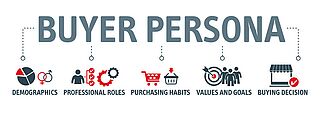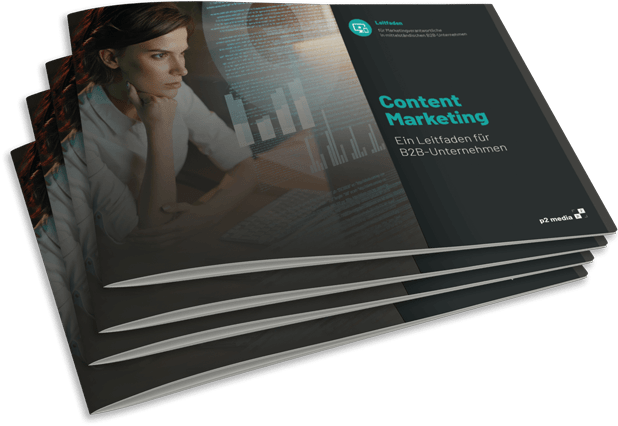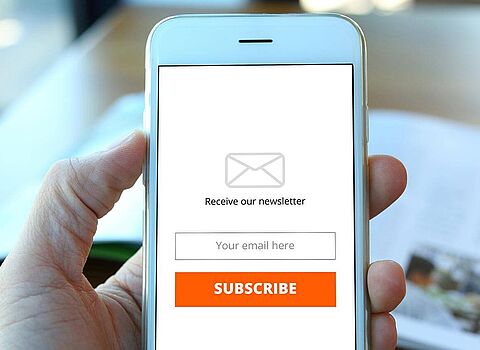A buyer persona profile describes a typical prospective customer or an ideal customer of certain products or services. By creating such customer types, marketing can be tailored to them with great precision. This provides advantages in both the efficiency and effectiveness of corresponding measures.
The term persona comes from the Greek and means faceor mask. In ancient times, actors wore masks to portray a role. In today's marketing and sales environment, such customer masks are generated to clearly depict the likely goals and pain points of the respective target buyers. The persons or personas to be addressed with the company's services become more human for marketing and sales in the course of this, which makes it more likely that they will be reached or convinced in a truly comprehensive manner.
Here you can read about the advantages of buyer personas in detail, what you need to pay particular attention to when developing them, what a customer persona actually looks like, and other key information on the topic.
Target group
By definition, the target group is a specific set of market participants. This group of people reacts to marketing and sales measures more homogeneously than the market as a whole - after all, they are particularly addressed by the products of the respective company.
At the heart of the formation of target groups is the segmentation of the entire market according to certain characteristics. This market segmentation is carried out, for example, using a mix of socio-demographic data. Typical here is the recording of age, gender, education, income and marital status. Target groups, as the name suggests, are ultimately always several people with identical characteristics or prerequisites. Individual differences and details are not taken into account here.
Buyer Persona
Buyer person as, on the other hand, are much more detailed and also include challenges, wishes, and goals.
With the help of buyer personas, marketers have the opportunity to give the target group or individual persons in it a face. When profiling, marketers are forced to take the perspective of their ideal customer types from a personal point of view.
With this ideal customer profiling, it is possible to delve deep into the character of a representative probable buyer of the target group. Specific customer pain points, needs, preferences, motivators and general behavioral preference can be identified, understood and used for highly targeted marketing.
Why do you need buyer personas?
"Our sales department knows our target group and can address them precisely - why should we go to the trouble of creating buyer personas?":
In fact, many companies still have such and similar objections when they first come into contact with the concept of buyer personas.
In most cases, the above statement is true in terms of target group knowledge, but there are two problems with it:
- A target group does not buy! It is always a person who searches, decides and buys.
- Today, a very large part of the decision-making process takes place online before a purchase is made. Salespeople usually have no direct contact with individuals in their target group during this phase.
Buyer personas can reliably remedy this situation.
First of all, they give a face to the respective target group or to individual, particularly important people from this group. Those responsible get to know these people on a much more personal level than would be possible when looking at a target group. The better these customers can be addressed and convinced.
- If it is not known what the various people in the target group want to achieve and what makes this or that type of customer tick - i.e., if no real empathy is brought to bear on the situation of the individual - probable buyers can neither be optimally reached in person nor served online with suitable target group content or persona content at the right touchpoints.
- In modern marketing, it is always important to remember: buyers no longer want to be reduced to a target group or even a customer number. Especially in the abundance and anonymity of the Internet, many want their concerns to be addressed, to be understood as fully as possible, and to be able to receive personal attention.
- A good salesperson knows his customers - their pains, goals and decision-making structures. In conversation, he senses tendencies as well as the smallest signals and reacts to them. Online, however, this is hardly possible. By the time contact is actually sought with the sales department, the decision criteria have already been largely determined by information available via specific web content.
- Accordingly, appropriate empathy for the desired customers should already be built up in the online decision-making phase and, based on this, the approach, content, touchpoints, and other customer-specific processes should be defined. Online marketers obtain the necessary in-depth knowledge for this from buyer personas - often also called marketing personas in this context.
- In addition to typical areas of application in marketing or for website strategy and in sales, information from personas is particularly interesting in product management. Using these, products can be perfectly tailored to target customers in the course of their development and product roadmaps can be developed. Customer service also benefits. Personas can be used to create an incomparably positive and personal customer experience.
What are negative personas?
A negative persona is practically the opposite of the ideal customer. Such personas represent customer types who are hardly or not at all desirable as buyers.
These are not so much people who have no use at all for the products offered, but rather those whose demands are too high for individual offers or customers for whom the acquisition costs are too high in relation to the ROI achieved.
Such personas do not necessarily have to be rejected. However, it is advantageous to recognize them before a deal is made and to take appropriate precautions. At the online level, targeted information can be played out via which negative personas do not even consider the products offered.
What steps do you need to follow to develop a buyer persona?
When creating buyer personas, there are generally five steps to follow.
First, identify the buyer personas that are specifically important for your business model.
It is best to draw up a list of possible buyer personas based on the following questions:
- Who do your salespeople primarily talk to when contracts are signed in your segment?
- Which entities typically make decisions about purchasing your goods or services?
- With whom is the greatest influence on the purchase of your offerings?
- Are there influencers to consider or powerful influencers when it comes to buying your products?
- Who else sits in the buying center with your customers?
- Who else can you realistically reach well in terms of buying your products?
First, you should allow for all suggestions during your creative pre-work. Then, in the second step, prioritize your buyer personas according to the following two criteria:
- Influence on the purchase decision.
- Reachability through marketing and sales.
Of course, you can create buyer persona profiles relatively quickly on the basis of theoretical values and/or experience. However, you can obtain much more differentiated and useful information by interviewing important people in your target group. Particularly useful people here are existing customers, leads, lost leads, potential buyers, and competitors' customers.
There is no standard questionnaire for such interviews. However, you can use five topics as a guide - the "5 Buying Insights for Buyer Personas" by Adele Ravella, founder of the Buyer Persona Institute.
- Triggers (Priority Initiatives): What will entice prospects to consider your offerings and what won't?
- Benefit Analysis or Success Factors: What operational or personal successes do buyers benefit from when they choose your product?
- PerceivedBarriers: Do interested parties have concerns that your product or service is not the best solution after all - and how do these manifest themselves?
- Buyers Journey: What influences the buying decision in detail during the evaluation of an option (who, what, why)?
- Decision Criteria: What do prospects find most useful about competing products and what do they expect to gain from them?
Experience shows that eight interviews are usually sufficient to gain a good insight into the buyer persona. Often the answers are repeated afterwards.
After obtaining specific data in the topic areas, transcribe the interviews and look for meaningful quotes. These are entered into a table. Usually, about 15 to 20 such quotesresult per interview.
You should now assign these to the five topic areas so that there are about 20 to 40 quotes per topic area.
You then summarize these into so-called key messages in a cluster.
In the end, you will have about five to ten key messages per topic area. In total, this results in 25 to 50 key messages for five topic areas. Finally, you use these insights to create your buyer persona profiles.
Ideally, you create your buyer personas with key people from marketing, sales and other relevant departments as part of a workshop.
At the beginning, it is important to present the results of the interviews.
Written handouts for the participants are an advantage here. Now use a prefabricated template, such as the one we have provided as an example below, and Together with your team, answer the most important questions around your buyer personas.
Enter the data. The questions are partly derived from the topic areas. You can also use the template shown below as a guide.
But be sure to also consider whether there are any special questions in your company context.
The more precisely and individually you proceed, the more precise the persona will be.
Buyer persona profiles should not be set in stone. Keep in mind that their target customers evolve - and so the associated personas should be continuously updated as well.
Ideally, interviews should be conducted regularly, not just initially.
The quarterly strategy review common in inbound marketing is a good opportunity to update the buyer personas as well.
The interview results should then flow back into the profiling or the list of key messages.
What is the minimum number of people and questions that should be considered to create a buyer persona?
Of course, you first start with a buyer persona.
However, additional profiles are almost always required, since almost every company has people with slightly different prerequisites that are relevant to marketing and sales.
There is no right number of personas.
Some companies with a broad product range use 15 to 20 personas, but for others two or three are enough.
The possible questions, the answers to which lead to the Buyer Persona Profiles, are similarly flexible.
The general catalog includes around 80 typical questions. But not every question fits every company or persona. Here, a recommendation of the number is very difficult.
However, three questions should not be missing:
- What are the persona's goals?
- What problems does the persona have?
- How can help be provided?
As already indicated, the diversity of the company's own offerings serves as a good orientation for the number of personas.
If numerous products are sold and their areas of application differ greatly, more personas are required than with - to put it exaggeratedly - only a single product. The latter is extremely rare - there are almost always at least variants. Thus, several personas should be used in almost every case.
- What makes the person (hobbies, interests, etc.)?
- How does he or she appear?
- Which communication channels does he or she prefer to use?
- What is the information behavior (online/offline, which channels)?
- What is the purchasing behavior (online/offline)?
- Who influences the person (work colleagues, friends, family, role models, etc.)?
Conclusion
With buyer personas you give your target group a face - or in most cases even several faces. This is extremely helpful for maximally efficient and effective marketing. You can carry out exactly those measures that really appeal to your target customers - and because you are sure to reach them, you are especially likely to really convince them.
Use all the information you can get for your buyer personas. You will get the greatest possible yield for maximally useful personas from conducting and evaluating interviews. The more differentiated your approach, the more useful the results will be.
Our support around the topic Customer Journey:
- Together with you, we create relevant customer profiles and derive a professional customer journey.
- We determine relevant channels and design an individual customer journey map specifically for your company.
- Based on this, we outline a positiveuser experience along all relevant touchpoints and implement it programmatically.
- In addition, we are happy to support you in the strategic alignment of lead nurturing with the defined customer journey and develop concrete content modules for the respective phases of the buying process.
For holistic and successful online marketing, we are also happy to take care of the following topics:
Oliver Parrizas will be happy to answer any questions you may have on the subject. +49-800-911-91-91












